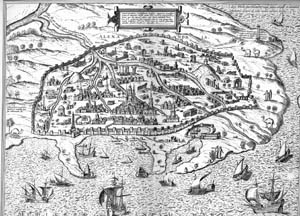The study of Alexandria's water system
4th century BC to 19th century AD
Isabelle Hairy
As with Istanbul, the town of Alexandria developed over an ensemble of fresh water "cisterns", storage volumes especially common in Mediterranean countries. These cisterns permitted the very existence of the city and directly determined its demography from the town's birth until the dawn of the 20th century.
'The supply of drinking water, always a major concern at the foundation of a town, certainly attracted considerable attention during the construction of Alexandria and its subsequent remodellings.
Alexandria was built upon a strip of land between the Mediterranean Sea and Lake Mariout. Since there was no direct access to drinking water, such as rivers or springs, it was necessary to bring water to the future city. The digging of a canal, or khalig, from the Canopic branch of the Nile at Schedia that would run some 27 kilometres to Alexandria, testifies, from the creation of the city, to the founders' desire to assure a regular supply of water that could respond to the considerable and growing quantities of water required for domestic, industrial and agricultural needs. It stands as proof that the town from the first instance had been conceived as one that would expand remarkably.

|
Map of Jansson (1619)
|
|
Archives CEA
|
In effect, during the Hellenistic era, Alexandria was one of the greatest cities of the Mediterranean world. In the year 60 BC, Diodorus of Sicily estimated the population at 300,000 free citizens, which would allow for a total population of around half a million souls. Thus, one can imagine the importance of this canal, an importance that is well underlined by the numerous acts of dredging and repairing that were undertaken during the Ptolemaic, Roman and Arab periods. If the growth of the town was directly linked to the creation and maintenance of the canal, then the town's decline occurred at the same time as the canal silted up and was blocked.